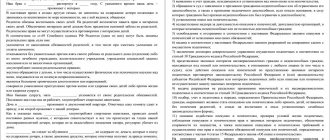In a family with children, the divorce process ends with the child remaining to live with one of the parents. And the second one in this case has to pay alimony to ensure decent conditions for development and growth. It is understood that the mother will spend these funds for their intended purpose.
However, some child support payers do not really believe in this and are interested in options for transferring money directly to the child. In any case, before making any decision, you must first communicate with your ex-wife.
Deduction from wages
Collection of alimony from wages is carried out by calculating and transferring alimony payments by the accounting department of the enterprise where the debtor is employed. The basis for such actions is a writ of execution, which can be presented in the form of a writ of execution, a court order or a payment agreement.
The calculation of alimony in a fixed or shared value is carried out after the deduction of generally obligatory taxes from the accrued salary.
The process of deducting alimony from your salary is described here.
Advantages and disadvantages
The main advantage is the natural accumulation of these funds, since no one will be able to withdraw them before reaching the age of 18. Thus, after reaching adulthood, the child will be able to enter adulthood with good material support, which will allow him to solve the issue of housing, education and provide him with the initial search for a suitable job.
An equally significant advantage can be considered the complete peace of mind of the second parent paying child support. After all, all funds will be used only for what is necessary. For example, to pay for kindergarten, clubs, sections, as well as for food and necessary clothing. A parent or guardian will not be able to simply withdraw money from the account and buy something for themselves, since all expenses will be clearly regulated by the court and the bank.
The only drawback is that the payer is charged all expenses for this banking transaction. According to Art. 109 of the RF IC, bank commission when transferring funds, mail fees, etc. – all these expenses are not included in the amount of the transfer, but are collected additionally from the payer’s income.
Transfer to a bank card
Funds intended for the monthly maintenance of minors can be transferred to the recipient’s bank card if an agreement has been reached between the parties or collection is carried out forcibly, but the recipient has applied for the transfer of alimony in this way.
If the funds are held by the organization where the payer is employed, they can also be sent to the recipient's payment card by direct transfer from the current account.
Read more about transferring alimony to a bank card in this article.
Making a transfer through the accounting department
The accounting department of the organization in which the alimony payer officially works is charged with the obligation to make alimony payments if they receive the following documents:
- If the issue was resolved forcibly, then the FSSP sends a court verdict to the organization. When the document is delivered personally by the alimony provider, you will also need to write a statement. It must contain basic information justifying the need for the payment and the details by which it should be made.
- When the issue is resolved, so to speak “amicably,” then the accounting department receives an agreement and an application to conduct transactions based on it. Both the recipient of the money and the employee himself can submit documents.
To eliminate the possibility of any misunderstandings, it is necessary to correctly fill out an application with a request to transfer alimony to a plastic card. It should look like this:
- The header should contain the following information:
- full official name of the enterprise;
- all information relating to the applicant.
- Main part of the document:
- a detailed description of the situation and the basis for the transactions;
- details of plastic bank cards of the child and mother.
- The date the document was compiled and the signature of the originator.
Documents attached to the application:
- A copy of the identity document of the alimony provider and the applicant.
- The document on the basis of which payments should be made.
- Certificate with plastic card details issued by the bank.
Ready-made application forms can be obtained either from the court office or from a notary office.
The accounting department is obliged to transfer accrued funds no later than three days from the date the employee receives wages. All types of commissions are paid by the alimony payer. In cases where the company issues money in two installments, the accrual occurs from the second payment.
Pros and cons of paying alimony through accounting
An absolute plus is that there is no need to control the timing of the payment and its implementation. A disadvantage, and quite a significant one, may be the presence of delays in wages, which is automatically transferred to alimony. Late payment may be punished with penalties, which can reach 0.5% of the total accrual. And they are charged for each day of delay.
Contributions to the child's account
If alimony support is to be transferred to an account opened in a bank in the name of a minor, the child is given the right to dispose of such money at his own discretion.
Such transfers can only be made in the following cases:
- There is an agreement on this between both parents, which is enshrined in a voluntary agreement;
- Full state support for the child in respect of whom payments are made;
- Establishing guardianship for a child or transferring him to a foster family;
- Adoption of an appropriate court decision.
Comprehensive information on this method of transferring funds is located at: https://alimente-info.ru/sposoby-uplaty-alimentov/na-schet-rebenka/.
Changing your payment method
By voluntary agreement, you can also change the method of receiving alimony as the parties wish.
To do this, by mutual agreement of the parties, you need to conclude a new agreement or make changes to the old document, but be sure to have it endorsed by a notary.
If the procedure for calculating child support is based on a court decision, then to change the method of transfer you should:
- indicate bank and current account details;
- file a claim to change the method of payment of benefits;
- contact the bailiff.
When considering a case in court, the question of the method of transferring money is decided by the judge, having previously ascertained the wishes of the parties . The method of receiving alimony is indicated in the decision.
The bailiff will consider the claim and, if the case is resolved positively, will transfer the data to the payer’s place of work.
A change in the procedure for paying alimony can be initiated by the recipient himself . The legislation restricts only the alimony payer from changing the procedure for paying benefits.
The recipient has the right to transfer alimony to the child’s account in 100% of the amount, for example, if the parent needs to leave the country or he has the finances to fully provide for the family.
Similar articles:
- How to write and submit a statement of claim for the collection of child support?
- Notarized agreement on payment of alimony
- How to apply for child support if we are not married, but the child is registered with the father?
- How is child support calculated?
- Procedure for calculating child support
- Previous entry What kind of alimony and in what amount is a disabled child entitled to?
- Next entry What to do if alimony is below the subsistence level?
1 comment on the article “Is it possible to transfer child support to the child’s own account?”
- 07/28/2018 at 20:56
Anonymous writes:AND UKAGO WILL HAVE A CARD FOR THE WALKER ON WHICH THE ELEMENTS WILL BE PRESENTED
Answer
Cash transfer
Regardless of the name of the document that forms the basis of child support, the parties can agree on a personal monthly transfer of money.
Even if alimony is paid on the basis of oral agreements, it is better for the father to ask the mother for a receipt, which will confirm the fact that the obligation undertaken was fulfilled.
The receipt is drawn up on a simple sheet of paper by writing a text in your own hand, which must indicate:
- Full name and passport details of both parties;
- Amount, both numerically and in words;
- Date of transfer of funds;
- The purpose of their use.
Sentences should not contain ambiguous phrases that allow their meaning to be interpreted in completely opposite senses.
The document can be drawn up either in the presence of third parties or without their participation. After the text, the person who received the money puts his signature with a mandatory decryption. Such a receipt does not require notarization.
Payment of alimony based on agreement
In order not to bring the matter to trial, former spouses can enter into an agreement that stipulates the procedure for making payments and their amount. At the request of the parties, it may also contain a clause regarding indexation and penalties in case of delay. It is allowed to supplement the document with other points, but provided that they do not contradict current legislation.
The completed document must be certified by a notary. The alimony payer can transfer funds either independently or with the help of accounting. Let's consider each of the listed options in more detail.
Alimony by mail
If the spouses live separately from each other, their marital relationship has ended, but this does not entail the termination of the rights and obligations in relation to common minor children . Parents must resolve the issue of paying child support: amount, order of transfer, frequency, etc.
If former spouses live in different localities, one of which has a joint child in their care, then sending alimony by postal order will be a convenient way for both parties.
Transfer of funds by mail involves sending from the nearest branch either by the parent himself or by the institution entrusted with such responsibility. This method of payment is one of the most reliable ; the transfer of alimony is confirmed by a receipt, which in turn is the main evidence that the parent fulfills his duties in good faith.
The negative features of this method are:
- high commission fees (if the transfer is less than 1,000 rubles, then the fee will be 5% of the amount + 40 rubles; from 1,000 to 5,000 rubles, then 4% + 50 rubles; over 5,000 rubles to 20,000 rubles - 2% + 150 rubles; more than 20 000 rubles - 1.5% + 250 rubles).
- at post offices there are often queues in which you can spend more than one hour;
- such a transfer cannot be accumulated in a non-cash account.
In order to send alimony by postal order, it is enough to have a passport (or other document confirming your identity) and the required amount of money.
The receipt must indicate:
- last name, first name, patronymic of the recipient;
- the amount of funds to be transferred;
- recipient's bank account or mailing address.
If the transfer is made to the recipient’s address, then he will be able to receive the funds only at his post office.
Example
After the divorce, the former spouses of the Kurochkins, Artem and Lyudmila, entered into an agreement on the payment of alimony, according to which Artem, every month before the 5th, had to transfer funds in the amount of 5,000 rubles for the maintenance of their joint young daughter by sending a postal order to Lyudmila’s account.
However, six months later Artem moved to another locality where there was no post office. The ex-husband continued to transfer alimony, but to Lyudmila’s bank card. Artem's unscrupulous ex-wife, Lyuda, filed a lawsuit to collect alimony for the purpose of profit, citing the fact that Artem has not transferred funds for the maintenance of his daughter since moving to another locality.
The plaintiff's claims were rejected by the court, since during the court hearing the defendant included a printout of bank transactions, which clearly showed that alimony was paid regularly in the required amount. The court ordered the parties to make changes to the method of transferring alimony.
Alimony as a percentage of earnings
A percentage of the parent’s earnings and other income is the most common method of collecting alimony through writs and lawsuits. This scheme is used when calculating payments for minor children in accordance with Art. 81 of the RF IC, if there is no agreement between the parents.
Alimony is collected by the court monthly in the amount of: for one child - 1/4, for two children - 1/3, for three or more children - 1/2 of earnings and (or) other income. In this case, the size of the shares may be reduced or increased by the court, taking into account the financial or family status of the parties and other noteworthy circumstances. The withholding of such alimony can reach 70% (Article 138 of the Labor Code of the Russian Federation, Article 99 of the Federal Law of October 2, 2007 N 229-FZ (as amended on July 3, 2016) “On Enforcement Proceedings”). The types of earnings and other income from which alimony can be deducted are determined by Decree of the Government of the Russian Federation of July 18, 1996 N 841 “On the List of types of wages and other income from which alimony is deducted for minor children.”
The advantage of this type of alimony is its size, which increases with earnings. The downside is the opportunity to reduce payments by reducing official earnings, which is often taken advantage of by unscrupulous payers.
Is it possible to receive child support without divorcing a marriage?
Question answer
Question
At the moment, I have two minor children left from my first marriage; they live with their mother. I regularly pay alimony, the amount established by a court decision. Can I give part of the alimony in the form of household items, clothing, food?
Answer
The legislation of the Russian Federation provides for the right of the payer to combine methods of paying alimony obligations. In order for you to change the payment method, you must enter into an agreement with your ex-spouse, which stipulates the changes.
Question
I pay child support to our common daughter, who lives with her ex-wife. However, recently I began to notice that she stopped caring for her daughter and spends most of the alimony on herself, buying new clothes, cosmetics, and entertainment. She has no other income and is not employed. She buys practically nothing for her daughter, which is why she wears clothes that are already too small for her. How can I limit my ex-wife's access to my daughter's child support?
Answer
It is impossible to limit it based on fact, since the mother is the legal representative of the child. You can go to court with a statement of claim, in which you demand that no more than 50% of alimony be transferred to your daughter’s personal account, money from which she will only be able to withdraw when she is 18 years old. Such a requirement must be justified by the waste of alimony for the needs of the ex-wife; it is advisable to provide evidence of this fact (photos, receipts, eyewitness testimony, etc.).
Through branches of the Russian Post
Transferring funds through Russian Post is convenient for residents of rural areas where it is not possible to use other methods of transferring funds, or if a court decision has established such a method of payment.
You can receive money in cash through the post office operator.
In addition, you can make a transfer to the recipient's bank or card account , additionally providing payment details.
To send money via Russian Post, the alimony payer must know information about the recipient:
- FULL NAME;
- Residence address and postal code;
- Recipient's account/card details.
It’s no secret that postal transfers take a lot of time, but Russian Post is improving its sending system every year.
YOU SHOULD KNOW! The commission for transfers through branches of the Russian Post is charged to the alimony payer. Payments are accepted in cash only.








